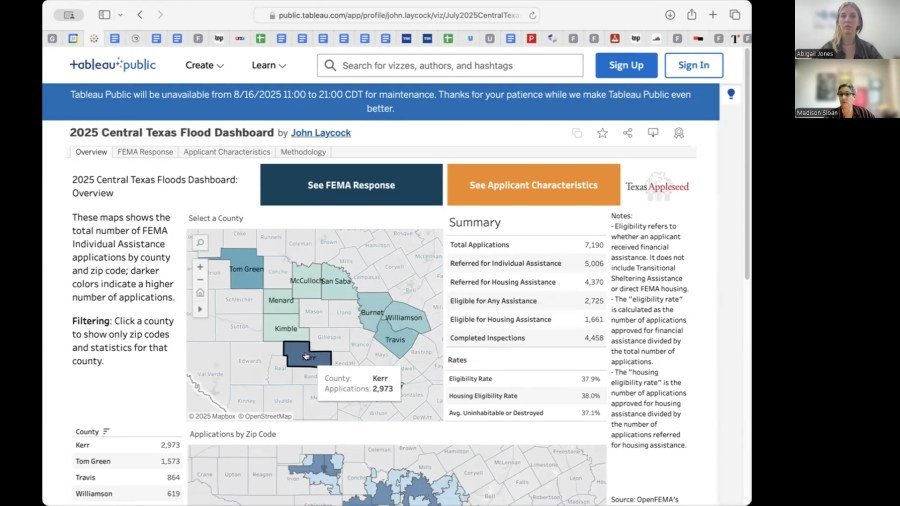Editor’s note: The above video is from previous coverage that aired on August 12.
AUSTIN (KXAN) — An Austin-based nonprofit organization has launched an online dashboard that visualizes information about what assistance claims have been filed with the Federal Emergency Management Agency (FEMA) in the aftermath of flash floods that hit Central Texas in early July.
Texas Appleseed, a nonpartisan, nonprofit policy and advocacy organization, created the “2025 Central Texas Flood Dashboard” to monitor FEMA assistance claims stemming from the floods. The dashboard is housed on the Disaster Equity Data Portal and covers the 10 Texas counties with disaster declarations that include Individual Assistance.
According to a release from Texas Appleseed, the dashboard disaggregates the number of applications, outcomes and self-reports of home damage by county and zip code. It also details the eligibility rate determined by FEMA, the average dollar amount of assistance provided and applicant characteristics, like age, income, home type, and insurance status, per the release.
“The dashboard will be updated on an approximately weekly basis as FEMA continues to release new data and respond to the damage from the floods,” John Laycock, senior research analyst for Texas Appleseed, said in the release. “We hope that by making this data more accessible, we can better identify potential problems, such as areas that might be underserved, and leverage the data to advocate for those communities.”
Madison Sloan, director of the disaster recovery and fair housing project at Texas Appleseed, said the nonprofit started disaster recovery and fair housing advocacy work in the aftermath of Hurricanes Katrina and Rita in 2005.
Sloan explained how the dashboard works and why it was created.
“So the dashboard tracks FEMA individual assistance data, so the data on the programs that assist individual Disaster Survivor households with housing and with other needs,” she said.
“The goal is to both make data accessible to help identify where there are issues, in as close to real time as we can… But it’s also to help identify, you know, who needs help and what kind of help they need. So when we’re thinking about… as a state, as a country, ‘how are we going to respond to this disaster, and what kind of resources do we need to get people?’ This data can help us see what kind of help people need,” Sloan explained.
Sloan said since FEMA is not intended to cover 100% of the needs following a disaster, Texas Appleseed can use the dashboard to help identify what is still needed in a community that isn’t being handled by FEMA.
“So for example, the average amount of home repair people are getting after this storm is a little over $8,000, so that’s obviously not enough to repair a home fully, and people are going to need more help to make sure they can they can return home,” Sloan said.
Something unusual in the FEMA response to the floods that the dashboard has helped highlight is the number of applicants who have been referred for individual assistance, Sloan explained.
“When you apply for FEMA, FEMA then has to refer your application to the Individuals & Household Program, and to housing assistance within that,” she said. “What we’re seeing in this data that’s really unusual is that FEMA is not referring as many applications, as usual, to individual assistance.”
Sloan compared it to the response following Hurricane Beryl last year. She said a month after Hurricane Beryl hit, more than 88% of Beryl applicants had been referred for individual assistance. Following the Independence Day floods, less than 70% of applicants have been referred for individual assistance by this point. Sloan added the rate also varies dramatically between counties.
She also said the data visualization helps highlight some of the long-term issues there will be following the floods.
“There need to be resources for housing recovery,” Sloan said. “There need to be resources to make people’s homes more flood resistant.”
“This data, is, in some ways, a warning sign that these are families who are going to need more help if they are not going to be permanently displaced,” she added.
Applying for FEMA assistance
The deadline to apply for Individual Assistance is Sept. 4, 2025.
Information on how to apply for assistance with recovery related to damage from the Central Texas floods can be found on the FEMA webpage for “Texas Severe Storms, Straight-line Winds, and Flooding.”
Texas Appleseed’s Homeowner’s Insurance and Disasters resource also has information on filing a claim.
